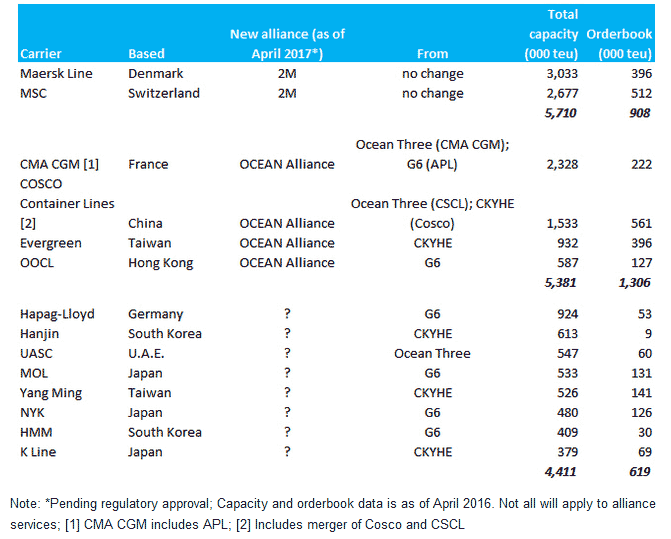Tough economic times drive sometimes drastic measures, and the ocean container shipping sector certainly is feeling financial pain, with rates at near record low levels and red ink on the income statements of nearly all the carriers.
Supply Chain Digest Says... |
 |
| Drewry expects a few additional mergers in the sector, and predicts that in the end there will be three main global alliances comprised of 13 total carriers. |
 |
What do you say? |
| Click here to send us your comments |
 |
| Click here to see reader feedback |
|
|
So-called "alliances" by different groups of carriers was one response to this financial situation, in which combinations of carriers would pool capacity and operations while maintaining independent sales, marketing and pricing activities. Among other potential benefits, the alliances might make it more likely that the new generation of giant container megaships - with capacity of more than 18,000 TEU - might sail with enough cargo to realize their potential costs savings per unit.
Just when things were somewhat settling down with four major alliances, the merger of two state-owned Chinese carriers - Cosco and CSCL - and the pending acquisition by France's CMA CGM of NOL/APL restarted the alliance game, now becoming a form of musical chairs in which some carriers may now find themselves without a seat.
A new OCEAN Alliance is now forming among CMA CGM, the new combined COSCO Container Lines, Evergreen Line and OOCL, coming from three different current alliances. The four carries will now take their plans to regulators in Asia, Europe and the US for approval, with the hope to begin alliance operations in April of 2017.
According to the joint press release OCEAN (initially for a period of five years) will cover more than 40 services in the Asia-Europe, Transpacific, Transatlantic and Asia-Middle East and Red Sea trades.
The alliance would be the second-largest in the world from a capacity perspective after 2M, the vessel-sharing partnership between Maersk Line and Mediterranean Shipping Co., the two largest carriers in the sector.
The move now also leaves eight major carriers, including Hapag-Lloyd, Hanjin, and K Line, as "orphans," for the moment not part of any alliance, as the ones they were participating in have now busted apart
If you are having trouble keeping score of all this, the analysts at Drewry have just compiled a handy table that compares the state of all the carriers in the pre- and post-OCEAN environment, which we publish below:
State of Container Shipping Alliances Before and After OCEAN Announcement

Source: Drewry Shipping
The new alliance will impact the relative shares of which groups carry freight from Asia to both Europe and North America.
Drewry says that before the new announcements, shares of capacity serving the North American market from Asia were as follows: the CKYHE alliances having been on top with a 30% share, followed closely by the G6 (26%) and 2M (23%), with the Ocean Three trailing at 15%, plus a small share for some non-aligned carriers.
(See More Below)
|
CATEGORY SPONSOR: SOFTEON |
|
|
| |
|
|
But with the OCEAN Alliance announcement, those shares will of course change, and if the approved OCEAN Alliance will take over as the largest carrier alliance on the Transpacific with a share of just under 36%, while in Asia-North Europe it will be within five percentage points from 2M, with a nominal capacity share of 31%.
The question then will be if the orphaned carriers all come together in a new alliance or if smaller grouping emerge. In fact, Drewry analysis shows that if all eight orphans combined, the alliance would have a greater capacity share than the OCEAN group on Asia to Europe sailing, and be virtually equal to OCEAN in the Asia to North America trade. However, Drewry does not believe all eight will come together under a single vessel sharing agreement, especially the three Japanese carriers in the orphan group.
Drewry expects a few additional mergers in the sector, and predicts that in the end there will be three main global alliances comprised of 13 total carriers.
"The structural industry change is about fewer, larger alliances comprising fewer, generally larger carriers than ever before," Drewry notes.
While alliances are changing the game in many ways, in the end "the carriers' end game will be to optimize their fleets and minimize costs," Drewry notes. "Alliances have thus far have failed to solve the most elusive conundrum of stabilizing freight rates, and we do not expect this to change."
What is your view of this new OCEAN alliance? If this industry consolidation good pr bad for shippers? Let us know your thoughts at the Feedback section below.
Your Comments/Feedback
|
|
Ibrahim
Manager, Trade Relations, AFRICAN SHIPPING LINE |
Posted on: Feb, 26 2017 |
|
| Good Post and a good insight into the current shipping trends. |
|
|